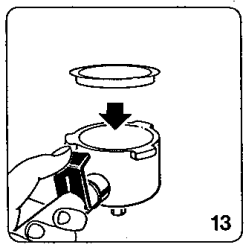
Krups 963 Mini Coffee Maker
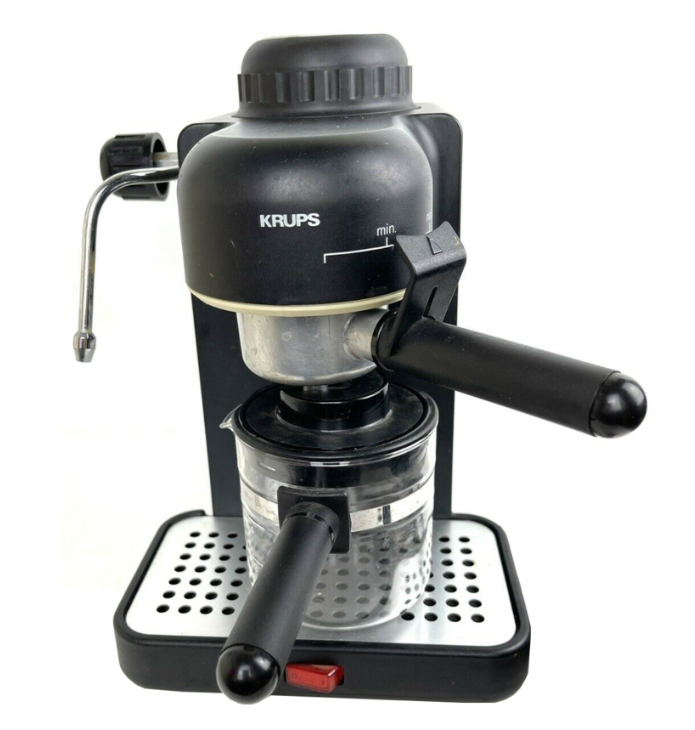
IMPORTANT SAFEGUARDS
When using electrical appliances, basic safety precautions should always be followed to reduce the risk of fire, electric shock, and/injury to persons, including the following:
- Read ~ instructions and information in this instruction book and any other literature included in this carton referring to this product before operating or using this appliance.
- Do not touch hot surfaces. Use handles or knobs.
- To protect against fire, electric shock, and personal Injury, do not immerse the cord, plugs, or appliance in water or other liquid.
- Close supervision is necessary when any appliance is used by or near children.
- Unplug from the outlet when not in use and before cleaning. Allow to cool before putting on or taking off parts, and before cleaning the appliance.
- Do not operate any appliance with a damaged cord or plug, or after the appliance malfunctions, or has been damaged in any manner. Return the appliance to the nearest authorized service facility for examination, repair, or adjustment..
- The use of accessory attachments not recommended by the appliance manufacturer may result in fire, electric shock, or personal injury.
- Do not use outdoors.
- Do not let the cord hang over the edge of the table or counter, or touch hot surfaces.
- Do not place on or near a hot gas or electric burner, or in a heated oven.
- Always attach the plug to the appliance first, then plug the cord into the wall outlet.. To connect, turn the control to “off’, then remove the plug from wan outlet.
- Do not use the appliance other than intended use.
- DO NOT unscrew or remove the boiler cap while the machine is in operation. Wait until the brewing cycle is completed and all water and steam have been used up.
- Appliances with Glass Containers
- A. The container is designed for use with this appliance. It must never be used on a range top.
- B. Do not set a hot container on a wet or cold surface.
- C. Do not use a cracked container or a container having a loose or weakened handle.
- D. Do not clean the container with cleansers, steel wool pads, or other abrasive material.
SAVE THESE INSTRUCTIONS
SPECIAL CORD SET INSTRUCTIONS
Regarding Your Cord Set:
- A short power-supply cord (or detachable power-supply cord) is to be provided to reduce llsks resulting from becoming entangled in or tripping over a longer cord.
- Longer detachable power-supply c: cords or extension cords are available and may be used if care is exercised in their use.
- If a long detachable power-supply cord or extension cord is used, (1) the marked electrical rating of the detachable power-supply cord or extension cord should be at least as great as the electrical rating of the appliance, (2) if the appliance is of the grounded type, the extension cord should be a grounding-type 3–wlre cord, and (3) t~ longer cord should be arranged so that it will not drape over the c:ounter top or table top where it can be pulled on by children or tripped over.
- This appliance has a polarized plug (one blade is wider than the other).
As a safety feature, this plug will fit in a polarized outlet only one way. If the plug does not fit fully in the outlet, reverse the plug. If it still does not fit, contact a qualified electrician. Do not attempt to defeat this safety feature.
CAUTION
This appliance is for household use. Any servicing other than cleaning and user maintenance should be performed by an authorized service representative. Do not immerse the base in water.
To reduce the risk of fire or electric shock, do not remove the base. No user serviceable parts inside. Repair should be done by authorized service personnel only.
- Check the voltage to be sure that the voltage indicated on the name plate agrees with your voltage.
- Never use warm or hot water to fill the water container! Use cold water only!
- Keep your hands and the cord away from hot parts of the appliance during operation.
- Never clean with scouring powders or hard implements.
Before you make espresso.
Preparing espresso or cappuccino is different from brewing regular drip coffee. Electric Espresso/ cappuccino makers use steam pressure to force very hot water through the coffee grinds to make espresso and use steam to froth milk for cappuccino. Since these machines use steam pressure, you must read the instructions, CAUTIONS, NOTES, and ATTENTIONS, and use your espresso/cappuccino maker properly.
We recommend that ‘{OU get familiar with all the parts of your “Espresso Mini” before o perating the machine: Insert the filter in the filter holder, fit the filter holder into the filter rings, remove and replace the boiler cap, tum the steam knob on and off. Wash all loose parts in warm, soapy water, rinse thoroughly, and dry.
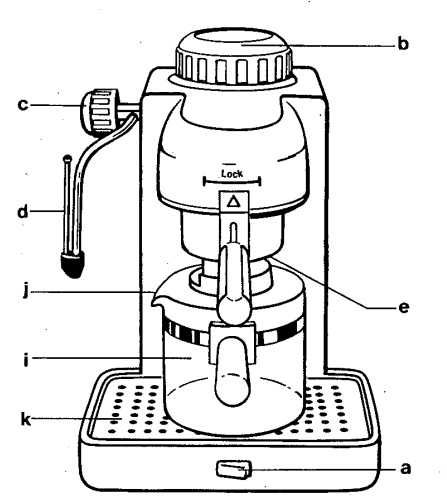
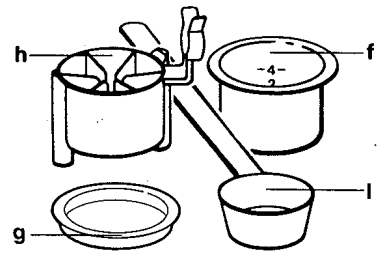
- a – On/Off switch
- b – Cap for boiler container
- c – Steam release knob
- d – Steam nozzle with “Perfect-Froth” attachment
- e e-Filter holder
- f – Filter basket for coffee
- g – Steam build-up plug
- h – Cup adapter
- i ~ Carate
- j – Carafe lid
- k – Overflow grid
- l – Measuring spoon
CAUTION – PRESSURE
NEVER open the boiler cap (bl or remove the filter holder (e) while your “Espresso Mini” is turned “ON” or as long as there is pressure in the boiler container.
NEVER move or remove the filter holder while the “Espresso Mini” is in operation and under pressure.
Please follow the Instructions listed below to see if the macl11ne is still under pressure. Follow these safety pre<:autlons when your machine is in use and ten to fifteen minutes after last use.
- Turn the On/Off switch to the “OFF” position and unplug the appliance.
- Carefully open the steam release knob (c) by slowly turning it counter clockwise. If steam comes out of the nozzle, then the water container is still under pressure. Close steam knob and proceed with instructions listed below.
- Take a pitcher filled with cold water and hold it under the steam noZ21e with noz:ile inserted into the pitcher. Than open the steam release knob (c) by turning n counter clo ckwise. Leave steam release knob open until no more steam comes out of nozzle. When finished tum steam knob clockwise to close.
- Now you can remove the boiler cap and the filter holder.
GENUINE ESPRESSO
Espresso is a far richer and stronger brew than regular coffee. It should he deep, dark, and delicious. Most people find that they enjoy it in small Quantities because of its richness and for that reason. Espresso is usually served in small (2- 2½ oz.) demitasse cups.
The mark of real espresso is its wonderful, inviting fragrance and its rich frothed topping: a light brown, cream foam called “crem.a”.. Your “Espresso Mini”, properly used. It will always produce espresso that is deep, dark, and delicious. Just follow the instructions and use lresn, well-roasted, pre11round espresso or espresso beans you grind yourself.
GRINDING ESPRESSO BEANS
If you grind your beans and use KRUPS “FAST-TOUCH” (model # 200), or “TOUCH-TOP” (model # 208). The approximate grinding time for 44 cups ·of espresso is 16-18 seconds. Remember, espresso requires a fine grind.
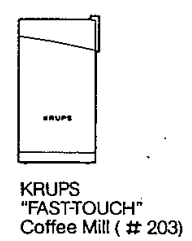
Making espresso
- Place your “Espresso Mini” near an electrical outlet, then plug in the machine. Make sure the On/Off switch is in the “OFF” position.
- Place your filter basket (f) into the filter holder (e) (see figure 2). The basket is marked on the inside, indicating 2 cups or 4 cups. Fill to the desired level, 2 or 4 cups.

- Fill the filter basket with ground espresso coffee. Pack the coffee lightly and clear any excess coffee from the rim of the filter holder. This will ensure a proper fit into the filter rings (see figure 3).
 ATTENTION
ATTENTION - Do not pack coffee tightly.
- Do not fill more coffee than indicated by the 4-cup marking. This might cause clogging or overflow (see under section “Problems and Causes”).
- • To insert the filter holder (e), line up the arrow located on the thumb guard of the filter holder with the arrow on the left side of the machine.
- Raise the filter holder into the brewing head and turn the filter holder firmly to the right, until it can go no further.
- The arrow on the filter holder should be as far right in the lock range as possible. If the arrow is not at least in the middle of the lock range, do not operate the machine. Rather, remove the filter holder and reinsert it as described above until the arrow is at least in the middle of the lock range (see figure 4).

- Once the filter holder is properly in place, it should never be moved or attempted to be removed while the “Espresso Mini” is in operation and under pressure.
- Unscrew the boiler cap (b) by turning it counterclockwise (see figure 5).

- Using the glass carafe, fill the boiler container with fresh, cold water (see figure 6).
 CAUTION
CAUTION- Never fill the boiler while your “Espresso Mini” is in “ON”. Any water that is added to the boiler chamber while the heating element is “ON” may produce hot steam at the point of impact. The hot steam is potentially dangerous to the user’s face, hands, or any other exposed body part.
- Never fill the water past the top of the metal band on the glass carafe. Any excess water placed in the boiler chamber will remain in the system after use, which, over time, may cause unnecessary calcium buildup in the system.
NOTE
You may want to add a little extra water to compensate for evaporation and absorption during the brewing process. However, DO NOT fill past the top of the metal band on the glass carafe. The glass carafe i) has markings on it for 2 cups and 4 cups, and steaming. - 2 cups of water yield 2 cups of espresso.
- 3 cups of water yield 2 cups of espresso, plus steam for frothing milk for a cappuccino.
- 4 cups of water yield 4 cups of espresso.
- 55cups of wateryield5 cupsespreyieldusforr frothing milk in a cappuccino. (This would be at the metal band.)
- Place the boiler cap (b) securely on the machine and turn it clockwise until it is secure (see figure 7).

- Place the carate lid fi) on the carate i) so that the lid opening points toward the pouring spout of the carate (see figure 8).

- Position the carafe under the filter holder. Make sure that the nozzle in the filter holder points through the opening of the carafe lid (see figure 9).
 ATTENTION
ATTENTION
Make sure that the overflow grid (k) is in place. - To make espresso directly into the cups, clip the cup adapter (h) onto the filter holder (see figure 10) and make sure that the cups are placed correctly underneath the two spouts (see figure 10a).


- Make sure that the steam release knob (c) is in the “closed” position (turn knob clockwise). * Then turn the On/Off switch on the “ON” position,,n and the indicator light will illuminate (see figure 11).

 CAUTION
CAUTION
During operation, pressure builds up inside the espresso machine. The pressure is contained by a seal between the holder and the machine. If it is not attached correctly or if it is moved during operation, the holder will not seal and can be blown off the machine under high pressure. This can cause burns from steam and hot coffee grounds, and cuts as the holder may shatter the glass carafe.
ATTENTION
You may notice a small amount of steam coming out of the filter holder. This is a normal function found in pressure systems of this type. DO NOT ADJUST OR REMOVE THE FILTER HOLDER. - After approximately two minutes, the water will have reached the proper temperature. The water at this time will pass through the coffee grinds, producing espresso in the glass carafe or in the cups, whichever you choose..
- Note that initially, the coffee will drip very slowly. If, after 4 minutes, no water passes through the coffee grinds, turn off the machine, release pressure by following the instructions under CAUTION – PRESSURE listed below, then remove the filter holder, empty coffee grinds, and start from the beginning.
- Once the coffee has stopped brewing, turn “Off” the machine with the “On/ Off” switch, and the light will go out (see figure 11).
- Before you remove the filter holder for cleaning, make sure that the boiler is no longer under pressure. –
CAUTION – PRESSURE
NEVER open the boiler cap (b) or remove the filter holder (e) while your “Espresso Mini” is turned “ON” or as long as there is pressure in the boiler container.
NEVER move or remove the filter holder while the “Espresso Mini” is in operation and under pressure.
Please follow the instructions below first to see if the machine is still under pressure. Follow these safety precautions while your machine is in use and ten to fifteen minutes after last use.
- Turn the On/Off switch to the “OFF” position and unplug the appliance.
- Carefully open the steam release knob (c) by slowly turning it counter clock- wise. If steam comes out of the nozzle, then the water container is still under pressure. Close steam knob and proceed with instructions firsted below.
- Take a pitcher filled with cold water and hold it underneath the steam nozzle with the nozzle inserted into the pitcher. Then open the steam release knob (c) by turning it counter clockwise. Leave steam release knob open until no more steam comes out of nozzle. When finished turn steam knob clockwise to close.
- Now you can remove the boiler cap and the filter holder.
![]() CAUTION
CAUTION
Use caution when removing the filter holder; metal parts may still be hot. To remove the filter holder, turn the filter holder to the left, past the “min” (minimum) markings until the filter holder dislodges from the machine.
ATTENTION
Since the metal parts might still be very hot, cool them down by running cold water over them.
To make more espresso, proceed as follows:
- Check to see if the boiler is empty and not under pressure (see section “Caution – Pressure”)
- Remove filter holder (e).
- Emoty filter basket (f)
- Review steps 1-14 of this section
CAPPUCCINO
Cappuccino takes its name from the chocolate hues of the robes worn by the Capuchin monks who favored this delicious dessert coffee. While cappuccino is traditionally made up of espresso and frothed milk, it can be tailored to one’s taste with cinnamon, sugar, chocolate flakes, or even liquor. Its versatility makes cappuccino a worldwide gourmet choice.
- The first step in making a cappuccino is to make espresso. Therefore, fill the glass carafe with the amount of water which is required to make the amount of espresso plus additional water for frothing milk (see section Making Espresso).
- Fill a small pitcher ½ to ½ full with fresh, cold milk and set aside.
- As soon as the first drops of coffee are forced through the filter holder, you can start frothing milk..
- Hold the pitcher under the steam nozzle. Insert the steam nozzle with “Perfect Froth” tip halfway into the pitcher of milk. Tum the steam control knob almost a full turn. Hold the pitcher steady as you froth the milk (see figure 12). Leave the steam nozzle in the pitcher for approximately 45-60 seconds, depending on how much froth you want and the type of milk you are using.
 ATTENTION
ATTENTION - Do not brmilkmilka boilboil (1his will happen if large bubbles start from, ing at the surface of the milk).
- Do not let the perfect froth attachment touch the bottom of the pitcher (this will prevent you from frothing milk).
- Close the steam release knob (c) after the milk is frothed by turning it clockwise while the nozzie is still immersed in the milk. This will prevent splattering of hot milk and foam. If you prefer “stiff” foam, let the frothed milk stand for a minute. If you prefer “creamy” foam, use it immediately.
- Pour the espresso into a cup that has the capacity of at least z. Then add the steamed milk to the espresso and spoon on the frothed milk. The proportion between espresso and milk is to taste; iItalyyal,,y it is normally one part espresso to two parts milk plus the froth.
ATTENTION
The top closure of the Perfect Froth attachment (see figure 12a, Part A) has a very fine hole in it, which draws air into the milk. If this tiny hole gets clogged, “Perfect Froth” will not work properly. So never immerse the top closure in milk or foam.
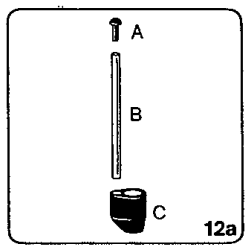
STEAMING WITHOUT MAKING ESPRESSO
- Insert the steam build-up plug (g) into the filter holder; see figure 13. Then proceed with steps 4 and 5 in the section “Making Espresso”.

- Fill the boiler container with cold water.
 CAUTION: For steam only, fill the glass carafe to the & mark on the carafe. This will always give you enough steam.
CAUTION: For steam only, fill the glass carafe to the & mark on the carafe. This will always give you enough steam. - Have your pitcher with milk or any other beverage you wish to heat ready.
- Proceed with steps 7, 8, 9, and 11 in section “Making Espresso”.
- Open the Steam Release Knob (c) immediately after turning the machine on. Stand by with your frothing pitcher.
 CAUTION: Do not leave the machine unattended at that time. It will take approximately. Half a minute after turning the machine on for the steam comes out of the steam nozzle. Proceed with steps 3b to 5 in the section “Making Capuccino”.
CAUTION: Do not leave the machine unattended at that time. It will take approximately. Half a minute after turning the machine on for the steam comes out of the steam nozzle. Proceed with steps 3b to 5 in the section “Making Capuccino”. - When all steam is released close the Steam Release Knob and turn off machine.
 CAUTION: In case you do not need all the water for steaming, proceed as follows:
CAUTION: In case you do not need all the water for steaming, proceed as follows: - Turn off the machine,
- release the remaining steam pressure into another container.
DO NOT CLOSE THE STEAM RELEASE KNOB BEFORE ALL STEAM IS RELEASED!
(see also the section. “( CAUTION – PRESSURE”)
CLEANING THE PERFECT-FROTH ATTACHMENT
For a thorough deaning of the “Perfect-Froth” attachment, remove part C see figure 12a). All parts should be rinsed in warm water. If the small suction opening in part A is plugged up, it can be opened with a fine needle.
Cleaning
Before cleaning, turn off the machine, unplug it, and allow it to cool down.
The filter holder, filter basket, carafe, carafe lid, the cup adapter, and the overflow grid can be put in the dishwasher’s upper rack away from the heating/drying element.
The machine itself wipes clean. Never immerse the body of your “Espresso Mini” in water or any other liquid. Clean the filter ring with a damp cloth and remove ground coffee. If there is water left in the boiler container, let the machine cool down, remove all loose parts, and empty through the top opening.
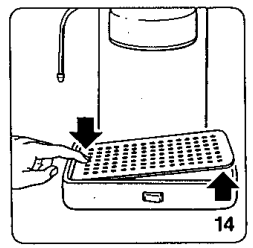
Cleaning the steam nozzle
Clean the steam nozzle each time after you have immersed it in the milk; otherwise inside of the nozzle becomes clogged, nd milk deposits on the outside harden and become difficult to remove. If this does occur, unscrew the nozzle (see figure 15) and remove all milk particles (use a needle and rinse under faucet); replace nozzle, and be sure to screw on tightly.
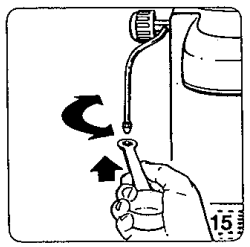
Cleaning the Perfect Froth attachment
For a thorough cleaning of the “Perfect Froth” attachment, remove part C (see figure 12a). All parts should be rinsed in warm water. If the small suction opening in part A is clogged, it can be opened with a fine needle.
![]() CAUTION
CAUTION
DO NOT try to open or disassemble the main body of the machine.
PROBLEMS AND CAUSES
(Always check if the machine is plugged in and if the machine is in the proper “On” position.)
Problem:
1. Coffee leaking from the filter holder
Cause
- The filter holder was not properly inserted
- The filter holder is not pushed in far enough
- Internal gasket is dirty, clean gaske..t Gasket without elasticity, replace
- The coffee powder was not cleaned off the edge of the filter holder
Problem:
2. Coffee does not come out
Cause
- No water in the boiler container
- No coffee in the filter holder
- The filter clogged up because the coffee mixture is too fine or pressed down too hard.
Problem:
3. Steam does not come out of the steam nozzle
Cause
- No water or not enough water in the boiler container
- The steam nozzle is clogged (see under “Cleaning”)
- Perfect Froth attachment is clogged (see under “Cleaning the Perfect Froth”)
Problem:
4. Not enough froth when frothing the milk
Cause
- Perfect Froth attachment touches the bottom of the
- Perfect Froth tip (see figure 12a) is clogged (part A) (see under “Cleaning the Perfect Froth”)
- The steam nozzle is clogged (see under “Cleaning”)
- Not enough water left in the boiler to steam for 45-60 seconds
Never move or remove the filter holder while the machine is in operation and under pressure.
Limited One-Year Warranty
Your KRUPS # 963 is covered by the following warranty (glass carafes are excluded from warranty):
If from date of purchase within one year theKRUPS product fails to function because of defects in materials or workmanship, KRUPS North America will, at its option, repair or replace the unit without charge, provided the owner can a proof of the date of purchase.
This warranty will be void if the function was caused by damage to the product by accident, misuse, use at a frequency other than marked on the product and/or described in the instructions, abuse,,e including tampering, damage in transit, or use for commercial purposes. This warranty gives you specific legal rights, and you may also have other rights which vary from state to state.
GUARANTEE OF PERFORMANCE
This fine KRUPS product is manufactured according to a rigid code of quality standards, and, with a minimum of care, should give years of satisfying service. However, should the need arise for repairs or replacement parts within or after the warranty period, please call our CONSUMER SERVICE DEPARTMENT:
(800) 526-5377
24 hours a day, 7 days a week
You will be provided with specific instructions on how to get your product repaired.
The department will also be able to answer any general product questions you may have.
Before calling the Consumer Service Department, please have the type number of your KRUPS appliance available. You must have this information before calling our Consumer Service Department so that we may better answer your questions.
The type number can be located by looking at the bottom of your appliance.
This product is Type # 963.
Any general correspondence can be addressed to:
KRUPS North America, Inc.
P.O. Box 3900
Peoria, IL 61612
For more manuals by Krups, visit ManualsLibraryy
Krups 963 Mini Coffee Maker- FAQs
How do I deep clean my Krups coffee maker?
To remove mineral buildup (descaling):
Fill the water tank with equal parts white vinegar and water.
Run a brew cycle without coffee.
Discard the vinegar solution.
Rinse by running 2-3 cycles with fresh water.
What does the “CALC” light mean?
The “CALC” light indicates that your Krups coffee maker needs descaling. Press the button to start the descaling program.
How do I exit descaling mode?
Press the “small cup” and “large cup” buttons simultaneously to exit descaling mode after completing the process.
Does the Krups coffee maker turn off automatically?
Yes, most Krups models have an auto-shutoff feature after brewing.
How do I use the mini coffee maker?
Fill the water tank with cold water.
Add ground coffee to the filter.
Place the carafe and press the brew button.
Can I use vinegar to descale instead of a descaling solution?
Yes, white vinegar diluted with water (1:1 ratio) works effectively for descaling.
Why is my Krups coffee maker flashing?
A flashing light usually means:
The drip tray or grounds container needs emptying.
The water tank is empty or incorrectly placed.
How often should I descale my Krups coffee maker?
Every 1-3 months, depending on water hardness.
More frequently if you notice slower brewing or odd tastes.
Does the Krups coffee maker need electricity?
Yes, it requires standard power (1000–1500W) to operate.
What’s the difference between cleaning and descaling?
Cleaning removes coffee oils & residue (use soapy water).
Descaling removes mineral deposits (use vinegar or descaling solution).

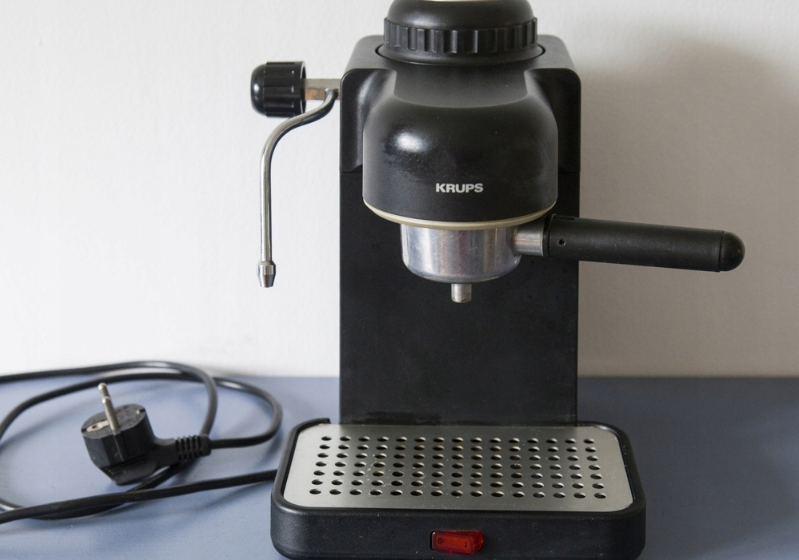
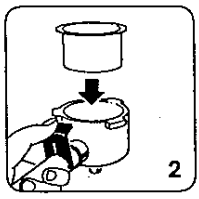
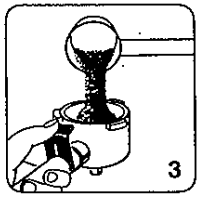 ATTENTION
ATTENTION 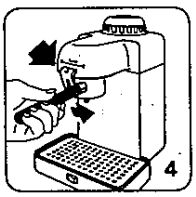
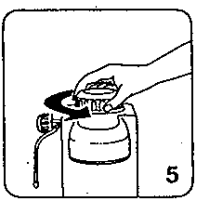
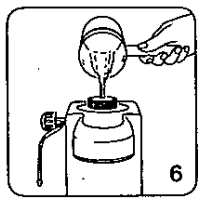 CAUTION
CAUTION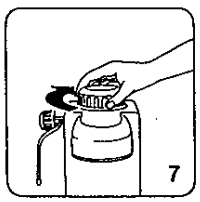
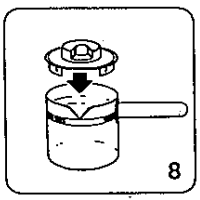
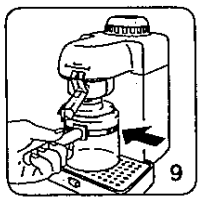 ATTENTION
ATTENTION 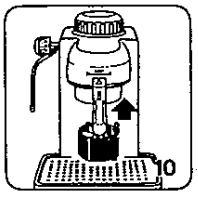
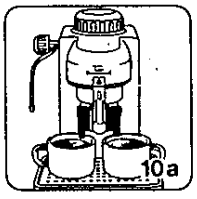
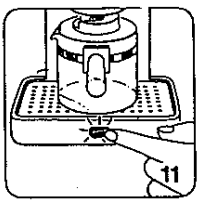
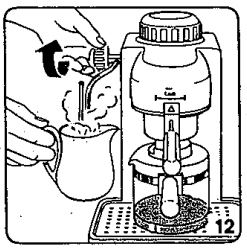 ATTENTION
ATTENTION